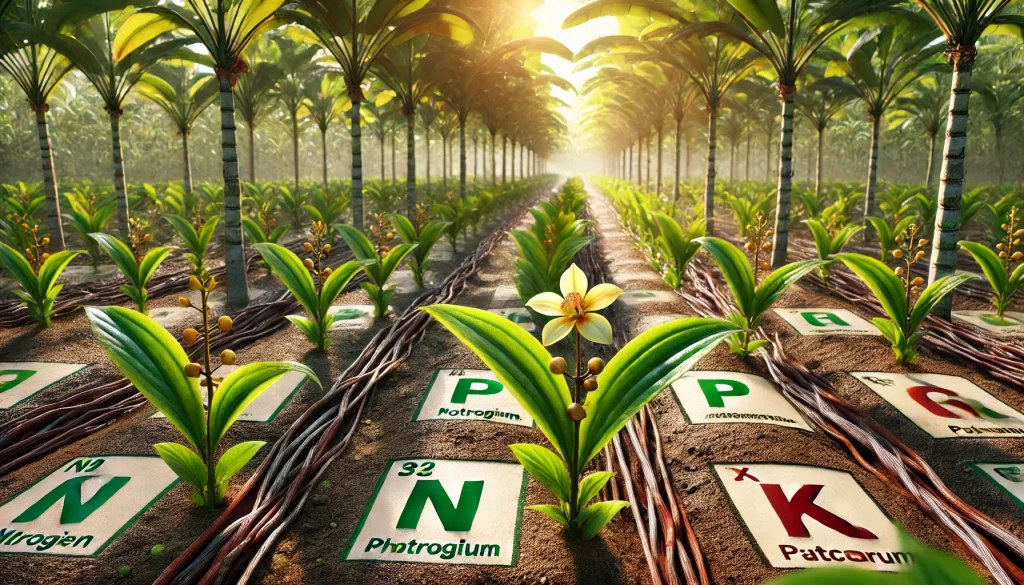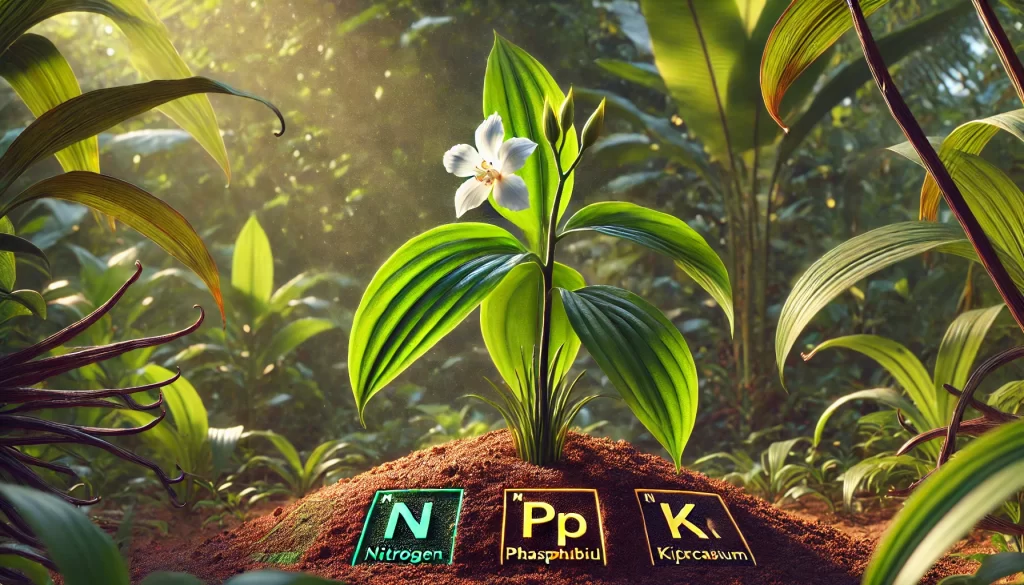Fertilization is a fundamental aspect for the successful cultivation of vanilla. This tropical orchid requires balanced nutrition to grow vigorously, flower, and produce high-quality pods. Providing the right nutrients in the correct amounts improves plant health, increases resistance to pests and diseases, and optimizes production. Below, the key nutrients needed for vanilla cultivation are detailed, along with practices and recommendations for effective fertilization.

Essential Nutrients for Vanilla
- Nitrogen (N):
- Function: Essential for vegetative growth, promotes the development of healthy leaves and stems.
- Recommendation: Moderate and constant fertilization during the vegetative phase helps maintain balanced growth without favoring excessively leafy growth that could weaken the plant.
- Phosphorus (P):
- Potassium (K):
- Calcium (Ca) and Magnesium (Mg):
- Function: Calcium strengthens cell walls, while magnesium is an essential component of chlorophyll.
- Recommendation: Incorporate sources of calcium and magnesium, such as agricultural gypsum or magnesium sulfate, into the soil to improve foliar health and overall plant resistance.
- Micronutrients (Zinc, Iron, Manganese, Boron, etc.):
- Function: Although required in smaller amounts, these nutrients are vital for enzymes and metabolic processes that affect flowering, growth, and pod formation.
- Recommendation: Perform periodic soil analyses to detect deficiencies and apply chelates or specific formulations as needed.

Fertilization Practices for Vanilla Cultivation
- Soil Analysis:
Perform soil analysis before planting and periodically to know the nutritional composition and correct deficiencies. This helps determine the exact doses of fertilizers to apply. - Organic and Sustainable Fertilization:
Incorporate organic matter such as compost, manure, and humus to improve soil structure, increase nutrient retention, and favor beneficial microbial activity. Organic fertilization is often combined with inorganic fertilizers in an integrated management approach to obtain immediate and long-term benefits. - Application Schedule:
Design a fertilization schedule that considers the different stages of the vanilla cycle. For example:- Apply nitrogen-rich fertilizers during the initial growth.
- Increase phosphorus and potassium during flowering and pod formation.
- Provide micronutrients according to soil analysis recommendations.
- Application Techniques:
- Fertigation: Applying fertilizers dissolved in the drip irrigation system facilitates direct absorption by the roots and efficient use of the product.
- Foliar Fertilization: In case of rapid deficiencies or for micronutrients, foliar application can be effective, allowing immediate assimilation through the leaves.
Additional Tips for Optimal Fertilization
- Continuous Monitoring:
Observe the plant for signs of nutrient deficiency or excess. Yellow leaves, spots, or weak growth may indicate nutritional problems that need correction. - Nutritional Balance:
Avoid excess of certain nutrients, especially nitrogen, as it can lead to excessive foliage growth at the expense of flowering and pod formation. - Adaptation to Local Conditions:
Nutritional needs may vary depending on climate, soil type, and other environmental factors. Adjusting general recommendations to the specific conditions of the region ensures more precise and effective fertilization.
Below is a nutrition table for vanilla cultivation organized according to the plant’s phenological stages. This table can be very useful for planning fertilization throughout the growth cycle, ensuring that the plant receives the appropriate nutrients at each phase of its development.
| Phenological Stage | Main Nutritional Needs | Fertilization Recommendations |
|---|---|---|
| Germination and establishment | Moderate Nitrogen (N) for root and foliage growthEssential micronutrients (Zn, Fe, Mn, B) in low doses | Apply a balanced fertilizer (N-P-K 10-10-10) diluted with compost or manureSupplement with micronutrient chelates if necessary |
| Vegetative growth | Increase in nitrogen to develop strong leaves and stemsCalcium (Ca) and Magnesium (Mg) for cellular strengthening | Fertigation with higher nitrogen content (e.g., N-P-K 20-10-10)Incorporate agricultural gypsum or magnesium sulfate periodically |
| Flowering and pod formation | Increase in phosphorus (P) and potassium (K) for flowering and pod curlingContinued supply of micronutrients | Apply phosphorus and potassium-rich fertilizers (N-P-K 10-20-20 or similar)Foliar fertilization with micronutrients according to detected deficiencies |
| Pod maturation | Maintenance of balanced nutrient levels for fruit qualityModerate reduction in nitrogen | Maintain balanced fertilization with emphasis on potassium and micronutrientsReduce nitrogen doses to avoid excessive foliage |
| Post-harvest and regeneration | Nutrients for recovery and growth of new shootsFocus on carbon and micronutrients | Incorporate compost and organic fertilizers rich in organic matterApply micronutrients and phosphorus to stimulate regeneration |
Note:
- Recommendations may vary depending on soil characteristics, climate, and specific crop management.
- It is essential to perform periodic soil analyses to adjust the doses and types of fertilizers according to the real needs of the plant.
- This table should be integrated into future articles dealing with fertilization, nutrition, and vanilla management, providing a clear and structured reference for readers.

This phenological nutritional guide ensures that vanilla plants receive the proper feeding at each stage of their growth, optimizing crop health and maximizing the production of high-quality pods.
Conclusion
Proper fertilization is key to achieving optimal vanilla production. By supplying essential nutrients and adopting sustainable and precise practices, growers can improve plant health, increase resistance to stress, and maximize the quality and quantity of pods. Careful nutritional management, based on soil analysis and constant observation, will allow for the development of a productive and sustainable vanilla crop in the long term.
 AgronoBlog – Agriculture Blog
AgronoBlog – Agriculture Blog 


